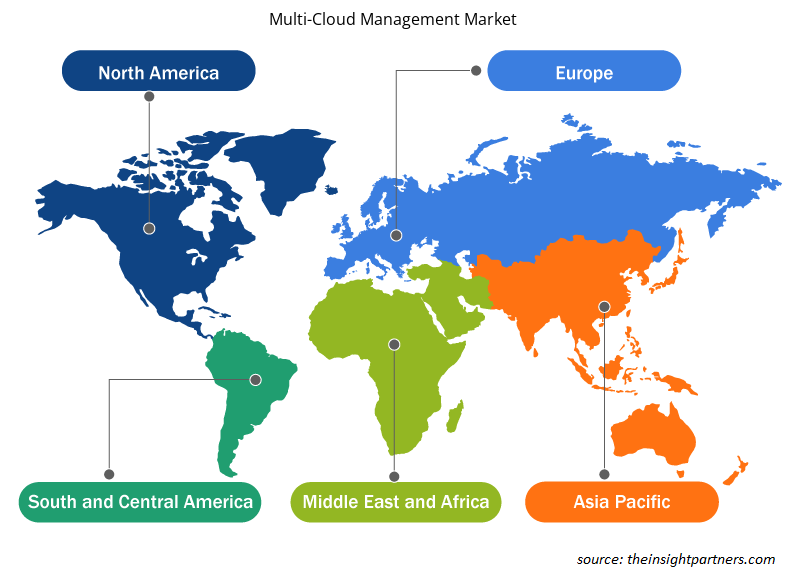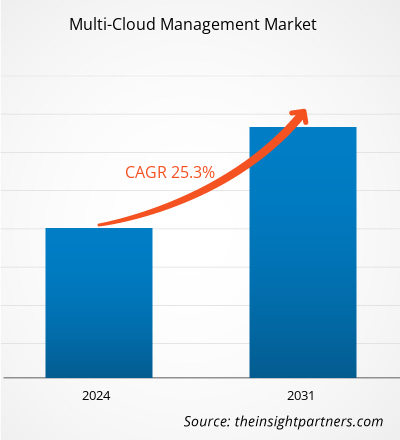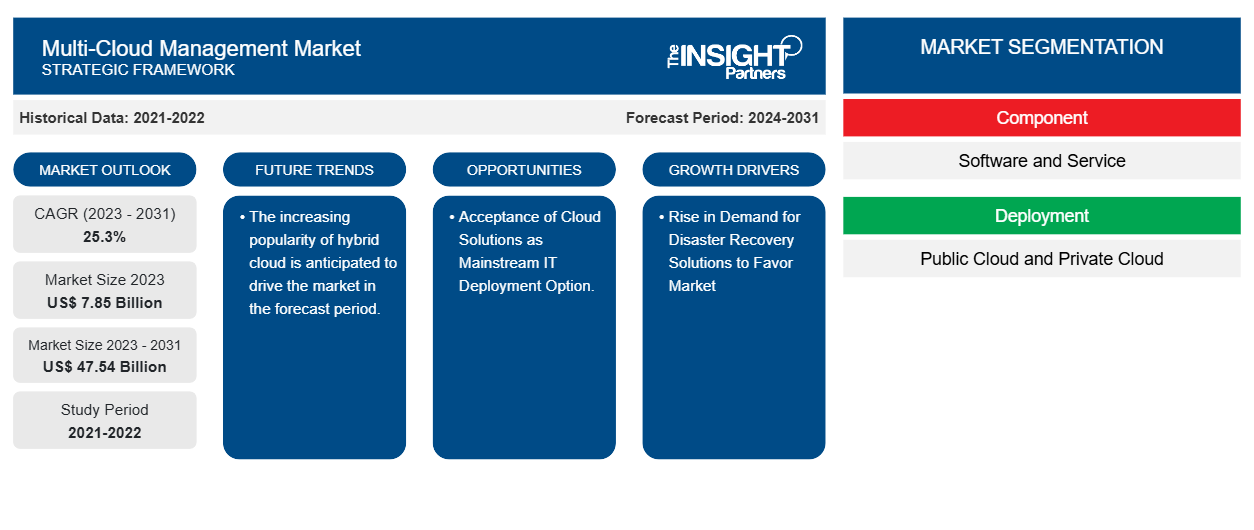多云管理市场规模预计将从 2023 年的 78.5 亿美元增至 2031 年的 475.4 亿美元。预计 2023-2031 年期间的复合年增长率为 25.3%。避免供应商锁定的需求激增。供应商锁定是指组织选择从其当前供应商转移业务但由于多种原因而无法这样做的情况,例如预计的成本、持续时间和切换的复杂性以及对灾难恢复解决方案的需求增加可能是多云管理市场的主要趋势和驱动因素。
多云管理市场分析
全球范围内,多云管理市场正在经历显著增长。这种增长归因于避免供应商锁定的需求激增以及对灾难恢复解决方案的需求增加。此外,混合云的日益普及、数据生成的增加以及自带设备 (BYOD) 和选择设备 (CYOD) 的兴起预计将在未来几年推动市场的发展。
多云管理市场概览
多云管理被视为一组工具和程序,使企业能够保护和监控跨多个公共云的应用程序和工作负载。多云管理解决方案使 IT 团队能够从单个界面管理多个云,并支持 Azure 和 AWS 等多个云平台。
定制此报告以满足您的需求
您可以免费定制任何报告,包括本报告的部分内容、国家级分析、Excel 数据包,以及为初创企业和大学提供优惠和折扣
-
获取此报告的关键市场趋势。这个免费样品将包括数据分析,从市场趋势到估计和预测。
多云管理市场驱动因素和机遇
灾难恢复解决方案需求上升,市场受益
灾难恢复 (DR) 是任何云部署的关键方面。根据世界备份日的统计数据,每月有 10% 的计算机受到病毒攻击,30% 的人从不备份数据。此外,包括工作人员删除未在其他地方备份的数据在内的意外事件占灾难的 29%。此外,市场上的各种公司都致力于提供灾难恢复解决方案。例如,持久多云灾难恢复解决方案使企业能够不受任何限制地实现应用程序移动性和数据保护,以实现业务抵抗力。IT 经理可以安全快速地保护混合和多云基础架构中的每个应用程序、操作系统、容器、数据库、数据等。
接受云解决方案作为主流 IT 部署选项。
全球大多数企业都接受云服务作为一种可行的 IT 部署模式。采用云服务的最普遍理由仍然是云作为交付平台的灵活性和数据安全性。许多企业已经迁移到一个或多个云服务,并影响其他企业采用云服务以获得竞争优势。云目前被认为是组织 IT 战略背景下的可靠部署模式,满意度仍然很高,目前全球三分之二使用云服务的最终用户预计在未来一年扩大其覆盖范围。
多云管理市场报告细分分析
有助于得出多云管理市场分析的关键部分是组件、部署、应用程序和垂直行业。
- 根据组件,多云管理市场分为软件和服务。预计软件部分将在预测期内占据相当大的市场份额。
- 根据部署,多云管理市场分为公共云和私有云。预计公共云部分将在预测期内占据相当大的市场份额。
- 根据应用,市场分为基础设施和资源管理、身份和策略管理、合规性管理、计量和计费以及配置和生命周期管理。基础设施和资源管理部分预计在预测期内占据相当大的市场份额。
- 按垂直行业划分,市场分为 IT 和电信、BFSI、政府、零售和消费品、旅游和酒店、医疗保健和生命科学等。预计 IT 和电信行业将在预测期内占据相当大的市场份额。
按地区划分的多云管理市场份额分析
多云管理市场报告的地理范围主要分为五个地区:北美、亚太、欧洲、中东和非洲、南美和中美。
北美主导了多云管理市场。北美多云管理市场的增长主要归因于数据的急剧增加、物联网和云基础设施的日益普及以及数据中心建设的激增。云计算是北美所有组织的主要趋势。云正迅速成为美国和加拿大企业的新常态。此外,美国和加拿大发达经济体对研发的高度重视迫使北美参与者将技术先进的解决方案引入市场。此外,美国拥有大量多云管理市场参与者,他们越来越专注于开发创新解决方案。所有这些因素都促进了该地区多云管理市场的增长。
多云管理市场区域洞察
Insight Partners 的分析师已详细解释了预测期内影响多云管理市场的区域趋势和因素。本节还讨论了北美、欧洲、亚太地区、中东和非洲以及南美和中美洲的多云管理市场细分和地理位置。

- 获取多云管理市场的区域特定数据
多云管理市场报告范围
| 报告属性 | 细节 |
|---|---|
| 2023 年的市场规模 | 78.5亿美元 |
| 2031 年市场规模 | 475.4亿美元 |
| 全球复合年增长率(2023 - 2031) | 25.3% |
| 史料 | 2021-2022 |
| 预测期 | 2024-2031 |
| 涵盖的领域 |
按组件
|
| 覆盖地区和国家 |
北美
|
| 市场领导者和主要公司简介 |
|
多云管理市场参与者密度:了解其对业务动态的影响
由于消费者偏好的不断变化、技术进步以及对产品优势的认识不断提高等因素,最终用户需求不断增加,推动了多云管理市场快速增长。随着需求的增加,企业正在扩大其产品范围,进行创新以满足消费者需求,并利用新兴趋势,从而进一步推动市场增长。
市场参与者密度是指在特定市场或行业内运营的企业或公司的分布情况。它表明在给定市场空间中,相对于其规模或总市场价值,有多少竞争对手(市场参与者)存在。
在多云管理市场运营的主要公司有:
- BMC 软件公司
- 思科系统公司
- 弗莱克斯拉
- 国际商业机器公司
- 微焦点国际有限公司
- Zerto 有限公司
免责声明:上面列出的公司没有按照任何特定顺序排列。

- 获取多云管理市场顶级关键参与者概览
多云管理市场新闻和最新发展
通过收集一手和二手研究后的定性和定量数据来评估多云管理市场,其中包括重要的公司出版物、协会数据和数据库。以下列出了多云管理市场的一些发展:
- Oracle 和 Google Cloud 宣布建立合作伙伴关系,让客户可以选择结合使用 Oracle Cloud Infrastructure (OCI) 和 Google Cloud 技术,以帮助加速其应用程序迁移和现代化。(来源:Oracle,公司网站,2024 年 6 月)
- Verizon Business 宣布推出网络即服务 (NaaS) 云管理,这是一项新服务,使企业能够在统一的在线门户中控制跨多个云环境(公共、私有和混合)的应用程序组件和网络架构。(来源:Verizon,公司网站,2024 年 2 月)
多云管理市场报告覆盖范围和交付成果
“多云管理市场规模和预测(2021-2031)”报告对市场进行了详细分析,涵盖以下领域:
- 范围内涵盖的所有关键细分市场的全球、区域和国家层面的多云管理市场规模和预测。
- 多云管理市场趋势以及驱动因素、限制因素和关键机遇等市场动态。
- 详细的 PEST/波特五力分析和 SWOT 分析。
- 多云管理市场分析涵盖关键市场趋势、全球和区域框架、主要参与者、法规和最近的市场发展。
- 行业格局和竞争分析涵盖市场集中度、热图分析、知名参与者以及多云管理市场的最新发展。
- 详细的公司简介。
- 历史分析(2 年)、基准年、预测(7 年)及复合年增长率
- PEST和SWOT分析
- 市场规模、价值/数量 - 全球、区域、国家
- 行业和竞争格局
- Excel 数据集
近期报告
相关报告
客户评价
购买理由
- 明智的决策
- 了解市场动态
- 竞争分析
- 客户洞察
- 市场预测
- 风险规避
- 战略规划
- 投资论证
- 识别新兴市场
- 优化营销策略
- 提升运营效率
- 顺应监管趋势























 获取免费样品 - 多云管理市场
获取免费样品 - 多云管理市场